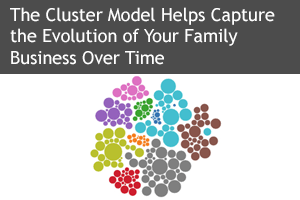Top Ten Family Business Facts | Fact #2: The Cluster Model Helps Capture the Evolution of Your Family Business Over Time
 Traditionally, family businesses are described as constituent of three overlapping circles:
Traditionally, family businesses are described as constituent of three overlapping circles:
1) the family,
2) the business, and
3) the ownership (Gersick, Davis, McCollom Hampton, & Lansberg, 1997; Tagiuri & Davis, 1996).
Recently, Michael-Tsabari, Labaki, & Zachary (2014) suggested the Cluster Model to update the two and three-circle models by providing a more detailed picture of the circles’ evolution over time.
While the original bivalent two-circle model appropriately describes a family that owns a firm (Tagiuri & Davis, 1996), Michael-Tsabari et al. (2014)’s study addresses the inaccuracies of the circle models when it comes to describing a family that owns more than one firm and suggests a more detailed perspective allowing to include in the analysis the different firms that the family owns to different extents.
Lesson #2: Putting on the lenses of the Cluster Model might help you better capture the evolution of your family business over time both in terms of the descendants driving this evolution and its outcomes.
Wondering what the Cluster Model means for you and your family business? Do you need some guidance on seeing your family business through this lens? Contact a Family Business Matters consultant today. Through conferences, continuing education programs, family business retreats, speaking engagements and private family business consulting services, Family Business Matters has assisted more than 450 family-owned businesses around the world chart their way through family business issues of all shapes and sizes.
This post is the second in a series by Rania Labaki highlighting the Top Ten Family Business Facts. To view the previous post in this series, follow this link. To review the full Top Ten Family Business Facts and to access a list of original resources, please visit our Family Business Facts page.
Rania Labaki — Author Bio




